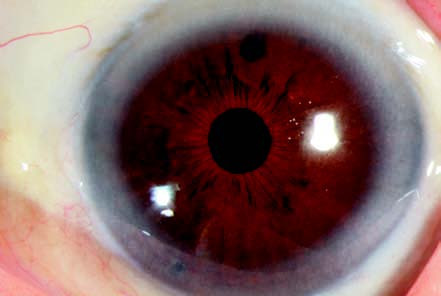Corneal arcus senilis refers to lipid deposition in the peripheral corneal stroma. Histopathologically, lipids are primarily deposited near the anterior and posterior elastic laminae. Approximately 60% of individuals aged 50–60 exhibit arcus senilis, and nearly all elderly individuals over the age of 80 have this condition. It is bilateral and typically begins with opacities at the superior and inferior corneal periphery, gradually developing into a complete ring.
The ring appears white, is usually about 1 mm wide, has a well-defined outer border, and a slightly hazy inner border. It is separated from the limbus by a band of clear cornea. Occasionally, it may present as a congenital anomaly in younger individuals, known as "juvenile arcus," where the condition often remains localized to part of the limbal region without forming a complete ring and is not associated with abnormalities in blood lipid levels.

Figure 1 Corneal arcus senilis
Arcus senilis is generally considered a degenerative change with a hereditary predisposition, though it may, in some cases, be indicative of hyperlipoproteinemia (particularly elevated low-density lipoprotein levels) or increased serum cholesterol levels. When it occurs in individuals under 40 years of age, it may provide a diagnostic reference for atherosclerosis. No treatment is required for this condition.